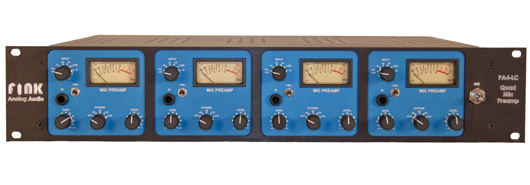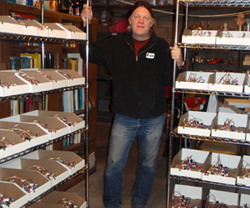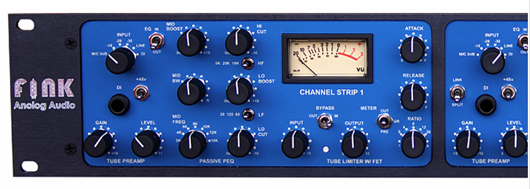Made in NY: Fink Analog Audio
From a distance, you might mistake Dennis Fink for a trucker, a contractor, or a retired lumberjack. He’s a tall bear of a man who wears clean, faded blue jeans and beat-up work boots, with a thick shock of grey-blond hair that reaches his collar.
If you never spoke to him, it might surprise you to hear he has two advanced degrees: a Masters in electrical engineering, and another one in business administration. But up close and in person, Fink has a soft voice, an easy smile, and an unpretentious kind of intelligence that’s uniquely American.
“During times of economic downturn,” Fink says, “the thing you really want to spend money on is the development of products. On innovation and engineering. That way, once the economy comes back again, you’ve got some new product out to whet the whistle. Some guys don’t get that.”
Fink has seen his way through plenty of business cycles in the audio world firsthand. He’s even worked alongside two generations of Bill Putnams – First, with Bill Putnam Sr. at UREI, Fink wired up some of the most highly regarded professional tools of the day, and then again with Bill Putnam Jr. at Universal Audio, he helped bring iconic vintage designs to a new mainstream market.
Today, Dennis Fink is at work on his own line of pro audio processors, and his modus operandi is cramming far more classic tools into a single 2RU box than you’d ever expect.
Two years ago, Fink Analog Audio hit the scene with the CS2-FA.
To put it simply, it’s a tube/FET dual-channel-strip. To put it bad-ass-edly, it’s two full-fledged 610-style preamps, two classic 1176 opto compressors, and two Pultec EQPs all in one 2RU box.
Oh yeah, and somehow, it’s made right here in New York and New Jersey and can be had for well under $4,000.
“I priced it out at some point,” says Fink, “and we figured out that if you were going to buy all those pieces separately, out on the open market, it would run you somewhere around $14,000.”
When pressed, Fink contends that he’s not just offering “lite” versions of these circuits so that he could cram them all into a small box and meet a pre-set price point. I ask him point-blank if he’d put his version of the 1176 from the CS2-FA up against a real one, by itself.
“Absolutely,” says Fink. “I would absolutely do that.”
And so he has, more or less.
After introducing the CS2 and then the CS1, Fink decided to try his hand at a stand-alone version of the classic 1176. But then he thought to himself, ‘I’ve got some extra room in here – Why don’t I just throw in an LA-2A while I’m at it?’ And so he did.
The resulting LC1-76LA is essentially two of the most iconic limiter/compressors ever designed, wired together in one box. Or at least, Fink’s version of them.
Of course, there are some differences. Most notably, Fink’s take on the 1176 sports a tube signal path that leaves it sounding a little more open, perhaps a little less aggressive, and with a slightly smoother top-end than the original. By default, it’s wired first in series with the unit’s LA2A-style compressor, but there’s a switch to change that.
“Using a fast limiter in front of a slow limiter is a classic recording chain,” says Fink. “A lot of great American recordings in the 60s, 70s and 80s were done like that.”
“But the cool thing is, with a single switch you can change the order. So instead it can first go into the LA2, the slower limiter, and then into the 76, the faster limiter. That’s a classic British limiter chain from the same period. With that chain you can hit the slow limiter at around 2-3 db [of gain reduction], just to set the overall level, and then you can just crush things following it. ”
“There’s also a third position that will give you two separate limiter/compressors – an independent 1176 and an independent LA2A, or at least, my version of them.”

Dennis Fink helped recreate the reissue 610 and the solo 610 for Universal Audio before starting Fink Analog Audio
This year, Fink also announced two more multi-channel units. Because his tube version of the 1176 compressor and his 3-tube take on the 610 preamp were built to work on small pre-fab cards, Fink realized he had the opportunity to create a couple more products at a negligible R&D cost.
Pretty quickly, the PA4 and LM4 were born. They’re Fink’s 4-channel versions of his preamp and compressor designs. Since they were already built to be compact, he says there was no need to dumb the circuits down to make all four work together in the 2RU chassis.
It sounds like a great idea from a designer’s perspective, but I asked Fink if in a digital age, he thinks buyers will really be attracted to a 4-channel analog compressor.
“Sure,” he says. “I mean, it’s basically four 1176s in a box. If you were in a live front-of-house situation it would be great on your buses. If you were doing a mixdown session, even in a small studio, and wanted to try some real analog compressors on drums, you could put these in the chain and print them all in one pass.”
“But there’s also still a whole bunch of high-end, working studios that just can’t have enough limiters. When you’re talking about 32, 48, 64 tracks on a large-format console, they need as many channels of great analog compressors in their stable as they can get. And can you imagine how much space it would take up to have four actual 1176s in the rack compared to one 2RU box?”
For a big guy, Fink gets how much power there is in keeping things compact.
The full line of Fink Analog Audio processors is available through Alto Music NYC, and at select retailers throughout the country. Product prices range from roughly $2,500-$3,800, and Fink says discount pricing is available on the CS2-FA through the end of 2011.
Justin Colletti is a Brooklyn-based producer/engineer who works with uncommon artists, and a journalist who writes about music and how we make it. Visit him at http://www.justincolletti.com.
Please note: When you buy products through links on this page, we may earn an affiliate commission.








